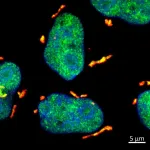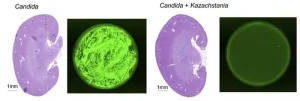(Press-News.org) For younger Black patients living in rural parts of the Southeastern United States, peer coaching is more effective than traditional clinical care in controlling high blood pressure, according to a new study led by investigators at Weill Cornell Medicine and NewYork-Presbyterian. The investigators learned that for people under age 60 who have persistently uncontrolled hypertension, the benefits of working with a peer health coach were equivalent to what would be expected from taking a low dose of blood pressure medication.
The findings were published March 18 in JAMA Internal Medicine. The randomized clinical trial was conducted by a team of researchers from Weill Cornell Medicine, NewYork-Presbyterian, the University of North Carolina at Chapel Hill, East Carolina University, and the University of Alabama at Birmingham, and included 1,592 Black patients with persistently uncontrolled high blood pressure who were being seen at 69 rural primary care practices.
“The improvements that we saw were important, especially because there was no new medication needed,” said first author and study lead Dr. Monika Safford, the John J. Kuiper Professor of Medicine and chief of the Division of General Internal Medicine at Weill Cornell Medicine and NewYork-Presbyterian/Weill Cornell Medical Center. “On a population level, this type of improvement translates into fewer strokes and heart attacks.”
Focusing on Preventive Healthcare in Underserved Populations
Dr. Safford and her collaborators focused on high blood pressure for this study because it was an area of concern for the healthcare providers they worked with on earlier research in underserved populations. The study was designed with four arms: practices were randomized to receive enhanced usual care alone or with the addition of peer coaching, practice facilitation, or a combination of peer coaching and practice facilitation, delivered over one year. The enhanced usual care approach provided each medical practice with educational information as well as blood pressure monitors to distribute to each enrolled patient. Peer coaching consisted of a structured educational/behavioral intervention provided over the phone. Practice facilitation consisted of a coach who helped practice staff to implement at least four hypertension-focused quality improvement activities.
Data analysis revealed that all groups showed some improvement, although across the entire study (patients aged 18-85) there was no significant difference among the four arms. Importantly, though, preplanned subgroup analysis showed that participants under age 60 in both the peer coaching and peer coaching/practice facilitation groups experienced a medically significant reduction in systolic blood pressure compared with those who received only enhanced usual care. The average reduction was 5 millimeters of mercury greater in this population subset than it was in other groups. Systolic blood pressure, the first and higher of the two numbers in a blood pressure reading, indicates how much pressure the blood exerts against artery walls when the heart contracts.
“We were not surprised to see this greater benefit in younger patients,” Dr. Safford said. “We know this is a population that has more room for improvement, because they are less likely to take their medications regularly.” The peer coaches were specially trained to educate patients on how to monitor and reduce their blood pressure. This included providing tips on limiting salt intake, increasing physical activity, and reducing stress in addition to taking medications daily.
Dr. Safford also noted an important trend in the practice facilitation intervention outside the confines of the study. The intervention focused on all patients with hypertension at each practice, not just the 25 patients enrolled in the study. And though practice facilitation didn’t prove more effective than enhanced usual care for the enrolled participants, the practice’s own estimates on how all their hypertensive patients were doing, regardless of whether they identified as Black or had persistently uncontrolled hypertension, showed a remarkable 6 percentage point increase in control, from 55 percent controlled at baseline to 61 percent controlled a year later, she said.
“Unfortunately, we did not have the resources to estimate practice-level blood pressure control at the practices that did not receive practice facilitation,” Dr. Safford said. “This finding still provides support for the promise of practice facilitation in these very under-resourced practices and warrants additional study.”
Leveraging Community-Academic Partnerships for Greater Benefit
An exciting feature of this trial was the community partnership model it used. Healthcare providers from across the 69 sites, peer coaches, and practice facilitators, as well as community advisory boards in Alabama and North Carolina provided valuable insights on trial design and on which interventions were most likely to benefit patients. “If we hadn’t had these strong partnerships, we would not have designed the study the way we did,” Dr. Safford said. “The peer coaches were able to suggest solutions that we never would have dreamed of, because they have such a deep understanding of their own communities.”
She added that peer coaching is a model that should be considered more broadly for helping underserved populations to manage chronic health conditions. “These populations have trust issues with the healthcare system, but they trust other people from their own community,” she said. “Leveraging that trust can have a very positive impact. It also helps create jobs for people in these communities.”
Many Weill Cornell Medicine physicians and scientists maintain relationships and collaborate with external organizations to foster scientific innovation and provide expert guidance. The institution makes these disclosures public to ensure transparency. For this information, see profile for Dr. Monika Safford.
Funds for this research were provided by the Patient Centered Outcomes Institute and by the National Heart Lung and Blood Institute, part of the National Institutes of Health, through grant UH2/UH3 HL130691.
END
Peer-coaching helps socially marginalized individuals lower blood pressure
2024-03-18
ELSE PRESS RELEASES FROM THIS DATE:
Estimated childhood lead exposure from drinking water in Chicago
2024-03-18
About The Study: The findings of this study indicate that childhood lead exposure from drinking water is widespread in Chicago, and racial inequities are present in both testing rates and exposure levels. Machine learning may assist in preliminary screening for lead exposure, and efforts to remediate the effects of environmental racism should involve improving outreach for and access to lead testing services.
Authors: Benjamin Q. Huynh, Ph.D., of the Johns Hopkins University Bloomberg School of Public Health in Baltimore, is the corresponding author.
To access the embargoed study: Visit our For The Media website at this link https://media.jamanetwork.com/
(doi:10.1001/jamapediatrics.2024.0133)
Editor’s ...
How DHX9 stress granules protect daughter cells from UV-induced RNA damage
2024-03-18
Mothers and daughters have a strong bond, yet do you know that connections reminiscent of this close relationship extend all the way to the cellular level? During the process of cell division, new daughter cells inherit a mix of genetic material and other molecules from their mother cells. This inheritance includes both beneficial components, which can help them for a robust start in life, and potentially harmful mutations or damaged molecules, posing significant challenges for the newly born daughter cells. How daughter cells manage and ...
Discover BMB 2024 press materials available now
2024-03-18
Embargoed press materials are now available for Discover BMB, the annual meeting of the American Society for Biochemistry and Molecular Biology. Top scientists and educators in the field will gather at the meeting, March 23–26 in San Antonio.
Reporters are invited to attend an exciting lineup of in-person scientific sessions in San Antonio or access press materials electronically. Register now or find more information in the #DiscoverBMB newsroom. Please note that only a limited number of complementary on-site press passes will be issued, so advance registration is recommended.
Explore the schedule at a ...
Newly identified yeast could prevent fungal infections by outcompeting rivals, study suggests
2024-03-18
Researchers at the Weizmann Institute of Science in Israel have identified a yeast that could be used to prevent invasive candidiasis, a major cause of death in hospitalized and immunocompromised patients. The study, to be published March 18 in the Journal of Experimental Medicine (JEM), shows that the novel yeast lives harmlessly in the intestines of mice and humans and can displace the yeast responsible for candidiasis, Candida albicans.
Millions of microbial species live within or on the human body, many of them being harmless or even beneficial to human health. The microscopic yeast C. albicans is commonly found in the intestines ...
NIH studies find severe symptoms of “Havana Syndrome,” but no evidence of MRI-detectable brain injury or biological abnormalities
2024-03-18
EMBARGOED FOR RELEASE
Monday, March, 18,2024
10 a.m. EDT
Contact:
NIH Office of Communications and Public Liaison
NIH News Media Branch
301-496-5787
NIH studies find severe symptoms of “Havana Syndrome,” but no evidence of MRI-detectable brain injury or biological abnormalities
Compared to healthy volunteers, affected U.S. government personnel did not exhibit differences that would explain symptoms
Using advanced imaging techniques and in-depth clinical assessments, a research team at the National Institutes of Health (NIH) found no significant evidence of MRI-detectable brain injury, nor differences in most clinical measures compared to ...
Clinical, biomarker, and research tests among US government personnel and their family members involved in anomalous health incidents
2024-03-18
About The Study: In this exploratory study, there were no significant differences between individuals reporting anomalous health incidents and matched control participants with respect to most clinical, research, and biomarker measures, except for objective and self-reported measures of imbalance and symptoms of fatigue, posttraumatic stress, and depression. This study did not replicate the findings of previous studies, although differences in the populations included and the timing of assessments limit direct comparisons. ...
Neuroimaging findings in US government personnel and their family members involved in anomalous health incidents
2024-03-18
About The Study: In this exploratory neuroimaging study, there were no significant differences in imaging measures of brain structure or function between individuals reporting anomalous health incidents and matched control participants after adjustment for multiple comparisons. U.S. government personnel stationed internationally have reported anomalous health incidents, with some individuals experiencing persistent debilitating symptoms.
Authors: Carlo Pierpaoli, M.D., Ph.D., of the National Institute of Biomedical Imaging and Bioengineering in ...
Can used coffee grounds help clean up environmental toxins?
2024-03-18
Global coffee consumption generates millions of tons of spent coffee grounds each year, which can be damaging to wildlife and the environment. However, new research published in the Journal of Chemical Technology and Biotechnology reveals that spent coffee grounds could be repurposed to act as a powerful adsorbent of bentazone, a herbicide commonly used in agriculture that is highly neurotoxic.
In the study, investigators found that when they used zinc chloride to activate the carbon from spent coffee grounds, the activated carbon showed a 70% efficiency in bentazone removal. ...
Largest-ever map of universe’s active supermassive black holes released
2024-03-18
Astronomers have charted the largest-ever volume of the universe with a new map of active supermassive black holes living at the centers of galaxies. Called quasars, the gas-gobbling black holes are, ironically, some of the universe’s brightest objects.
The new map logs the location of about 1.3 million quasars in space and time, the furthest of which shone bright when the universe was only 1.5 billion years old. (For comparison, the universe is now 13.7 billion years old.)
“This quasar catalog is different from all previous catalogs in that it gives us a three-dimensional map of the largest-ever volume of the universe,” says map co-creator David Hogg, a ...
Despite protection urban hawks still face an array of threats
2024-03-18
Life can be hard for a raptor. If you’re a teenager from the city, it’s even harder. That’s according to a new study published in the Journal of Raptor Research titled “Causes of Death of Female Cooper’s Hawks (Accipiter cooperii) from an Urban Setting in New Mexico, USA,” conducted by Brian A. Millsap and his colleagues at the US Fish and Wildlife Service. Over the course of 11 years, his research team affixed GPS transmitters to 158 female Cooper’s hawks in the Albuquerque area. Of those, 88 died and were found, allowing the researchers to investigate cause of death. The ...



